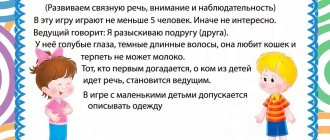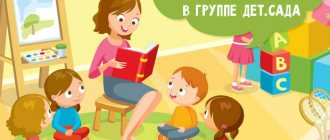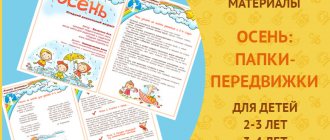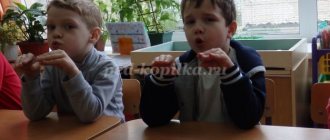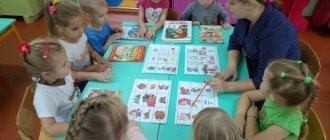Card index of games for the development of sound culture of speech
We invite you to familiarize yourself with a selection of games that are aimed at developing the sound culture of speech.
For the middle group of kindergarten
Game 1 “Sound Chain”
To play the game you will need a card with images of different objects. For example, in the first image the children see a tomato. They determine which letter the word begins with and then which letter it ends with. After this, the kids look for a picture that begins with the last letter of the previous word - in our case it is “P”. And so on for at least 10 words in a chain.
At the same time, children must name words and highlight the extreme sounds in them with their voice.
Game 2 “Look for a place for sound”
For this game, adults will need cards with various objects and cards with sound patterns (they always have one cell with the desired sound painted over).
You need to choose pictures in which the same sound occurs, but in different places (for example, a bus, a dress and a book).
Kids must match the pictures with the proposed diagrams.
Game 3 “Who lives in the house?”
You need to prepare flat houses with a letter in the attic and cards with images of objects. In the attic of each house there is a letter written - for example, s, z, k or p.
Place pictures on the table with words that begin with the suggested sounds. For the letter “k” – cat, goat and chicken, for the letter “c” – elephant, owl, dog, for the letter “z” – hare, zebra.
The children's task is to “resettle” the animals in the appropriate houses.
Game 4 “Buyer - Seller”
The game exercise is aimed at improving the differentiation of the sounds r-l and s-sh. The adult tells the children that today he will be a salesman in a big store, and the kids will be buyers. In this case, instead of money, students receive cards with sounds. Then the adult says that for these sounds in the store you can buy all the goods whose names contain one or another sound.
Products must be selected in such a way that they contain the sounds r, l, s and sh.
Game 5 “Match a Pair”
This game develops children's ability to distinguish words that differ only in sound.
Cards with the following images are laid out in one column: cat, braid, bear, cancer, roof, house, wasps. And in the second column you need to put the following pictures: whale, goat, mouse, poppy, rat, smoke, mustache.
The children's task is simple - to connect the words in pairs.
For the younger group of kindergarten
Game 1 “Blow the fluff”
The following games are aimed at developing phonemic awareness, speech attention and breathing, as well as reinforcing the correct pronunciation of sounds and whole words.
GCD on sound culture of speech in the preparatory group
Children stand in a circle, each of them is given a small piece of fluff (can be replaced with a piece of medical cotton wool). Kids are invited to place their palm in front of their face and blow on the fluff, saying “Fuuuu”. There must be at least five such repetitions.
Game 2 “Honey Lovers”
The adult tells the students that today they will be bears. And bears love honey very much. Kids should bring their “paw” to their mouth and imitate how bears lick honey from their paws. In this case, children do not need to touch their hands. Then you need to lick your lips in a circle.
The teacher must show all the movements to the children by example.
Then the teacher asks: “Are our bears full?” Children stroke their bellies and say: “Uuuuu” (several times).
The game is repeated at least 4 times.
Game 3 “Feed the birds”
The teacher says that she will be a mother bird, and the pupils will be her chicks. An adult invites the kids to run in a circle, flap their wings and shout: “Pi-pi-pi-pi.”
Then “mother” tells the children what they will eat now. Children should sit down, raise their heads up and open their mouths wide. Stay in this position for a few seconds.
Game 4 “Clock”
The teacher asks how the clock runs, the children answer: “Tick-tock.” Then the adult says: “How does the clock strike?” The children responded: “Bim-bom.” The teacher invites the children to ring the clock loudly, then show them how they walk - also loudly. Repeat sound combinations 5 times.
Then the children need to be shown how a small clock walks and strikes - while the children’s voice needs to be lowered. Repeat also 5-6 times.
Card index of games for older children
All the following game exercises are performed to reinforce correct pronunciation and differentiation of sounds.
Game 1 “Tell me like I do”
To play the game you will need a ball.
Children stand in a circle, and the teacher throws the ball and says any word with an emphasis on hard or soft sounds. The child repeats the word with the same accent. And so each child says in a circle.
If the baby fails to pronounce the word the first time, the adult repeats it several times.
Game 2 “Name the words”
The teacher asks the children to name all the words that contain the sound r or r. For each correct answer, the child receives a chip. The one who collects the most chips wins.
The same exercise is carried out with the sounds l or l.
Game 2 “Read the tongue twisters”
The teacher offers to pronounce the phrases correctly. They are pronounced in two breaths. The first two lines are for one exhalation, two more lines are for the second exhalation.
Suggested tongue twister: “Rain, rain, Don’t rain!” Let the gray-haired Grandfather reach home.”
First they say it loudly in chorus, and then each child speaks separately 2-3 times.
Game 3 “Make up the ending”
The teacher reads the lines of poems, and the children come up with the endings of the lines.
Poem examples:
“It’s not an alarm clock, but it will wake you up, it will sing, people will wake up.
There is a comb on the head, this is Petya. (cockerel).
We teach you to pronounce hissing sounds using the methods of Fomicheva and Bogomolova
I washed my face early this morning. (faucet).
The sun is shining very brightly, Hippopotamus has become. (hot).
Suddenly the sky became cloudy and lightning came out of the clouds. (flashed).”
Game 5 “Search for the same sound”
The teacher names pairs of words that have the same sounds. In this case, you first need to pronounce the syllables drawn out, and then clearly, stopping after each syllable.
For example, take the words “car” and “raspberry”. The adult says: “Maaaaashinaaaa,” then – “Maaaaaalinaaaa.” After this, he pronounces with a clear pause: “Ma-shi-na” and “Ma-li-na.”
Children must clap their hands for each syllable and count how many there are in each word. And then name those syllables that are repeated in both the first and second words.
Musical lessons for middle school children
Abstract of GCD for children of the middle group on the topic “There are different sounds”
PURPOSE: To enrich children’s understanding of noise and musical sounds (from everyday sound to musical sound). OBJECTIVES: Educational:
- Teach children to listen carefully to sounds, following the appropriate instructions of the teacher
Developmental:
- Develop musical and auditory concepts associated with discrimination and reproduction - Develop the ability for elementary improvisation, sound imagination, associative thinking.
Educational:
- To develop communication skills in children. Children enter the hall freely.
MUSIC DIRECTOR: Guys, we have a problem. I came to work today and the window was open. And in our hall I did not detect a single sound. Can you help me find them? CHILDREN: Yes! MUSIC DIRECTOR: Well, okay, we agreed, we will help each other together. Let's stand in a circle and greet each other. Communication game
The guys gathered in a circle, On the left is a friend and on the right is a friend.
Let's hold hands together and smile at each other. MUSIC DIRECTOR: Let's listen to how silence sounds, even though it seems to us that it is not audible. Children listen to silence
MUSIC DIRECTOR: What do you hear?
The children say what they heard.
MUSIC DIRECTOR: Would you be interested in living in a world where there is not a single sound?
The answer to the question will be a poem. Poem “Sounds” by A. Usachev Life would be terribly boring If life were silent. How wonderful it is to hear the sound: The sound of rain and the beating of the heart! We scream, laugh, breathe, We hear words and thoughts, We hear even silence... How a cat walks on the roof, How mice knock behind the wall, Wolves howl at the moon. A world without sounds would be sad, grey, boring and “tasteless”! Guys! Let's look around and think, where are the sounds hiding? Listen...there are many sounds around us (the teacher coughs and makes a rustling sound),
the children will recognize them.
CHILDREN: in musical instruments, in speakers, in a tape recorder MUSIC DIRECTOR: Let's clap our hands together, what happened? CHILDREN: the sound is hidden in the palms. MUSIC DIRECTOR: Now let's march. CHILDREN: The sound is hiding in the floor. MUSIC DIRECTOR: Children know everything in the world, There are different sounds: the farewell cry of cranes, the loud rumble of an airplane, the hum of a car in the yard, the barking of a dog in a kennel, the sound of wheels and the noise of a machine, the quiet rustle of the breeze. These are noise sounds, Only there are others: Not rustling, not knocking - Musical sounds are. So, let's go look for sounds. We need to say these words: We will walk along the path, We will now find the sounds. (Stop, listen) MP3 sounds - the rumble of an airplane
CHILDREN: The sound of an airplane.
MUSIC DIRECTOR: What do you think, is this a musical sound or a noise one? CHILDREN: noise. MUSIC DIRECTOR: Let's try to make it musical. To do this, you need to sing the sound: u-u-u-u-u! (Children sing (improvising), an airplane appears on the slides) An mp3 sounds - a car signal
(Children sing: bi-bi-bi,
a car appears on the slides
)
An mp3 sounds - a train signal
(Children sing: chuh-chukh-chukh,
appears on the slides train)
Sounds mp3 – thunder and rain SONG “CLOUD”
MUSIC DIRECTOR: And people have their own sounds by which we recognize a person. Progress of the game. The adult says: “Is it possible to recognize a person by his voice? Let’s close our eyes and guess whose voice it is, who is speaking.” Children determine by ear the timbre of the singer’s voice: “I’ll sing this song for you, my friend. Don’t open your eyes, who am I? Come on, guess.” GAME “RECOGNIZE BY VOICE”. MUSIC DIRECTOR: We will walk along the path, We will now find the sounds. (Children approach the table, find a note and a basket of vegetables, rhythmic sticks)
NOTE: This is a fruitful year, The garden is already ripe.
I give you a basket with vegetables and fruits. You will find sounds in them, Definitely, friends. YOUR AUTUMN “VEGETABLES” DIDACTIC GAME.
(Mor-kov-ka, ka-pu-sta, rap-ka) - they sing and knock with rhythmic sticks. We will walk along the path, We will now find the sounds. MUSIC DIRECTOR: So we come to our small music workshop. Here you can make noise instruments with your own hands. Children make noise instruments from Kinder Surprise eggs.
-Listen to sonorous instruments -Listen to quiet instruments -Do these instruments sound the same?
It's time to try out your noise tools in action. Let's play them all together. (kids are playing).
Somehow our musicians are completely out of control and only the conductor can calm them down. Take your tools and stand in a circle. Will Natalya Vladimirovna be the conductor? The music is loud - ringing kinders are playing, the music is quiet - quiet kinders are playing.
MUSIC DIRECTOR: You guys are great, you were able to collect all the sounds. We'll clap our hands together, stamp our feet briskly, puff out our cheeks all at once, and let's start dancing now. COMMUNICATIVE DANCE “CIRCL WITH ME, FRIEND.”
We recommend watching:
Notes on music in the middle group “Birds in Spring” Notes on an integrated lesson in fine art, literature and art for 6th grade Brain - ring in musical literature for sixth grade students at the Children's Art School From the experience of collaboration between a vocal group. Scenario development
Similar articles:
MUSIC. Lesson developments in music for 4th grade of secondary schools
Music quiz for schoolchildren of grades 9, 10, 11
Festival "Davydovsky". Results
Class hour 7, 8 class on the topic: How to protect yourself from trouble
Summary of GCD in the middle group in artistic creativity
Exercises to develop the sound culture of speech
All exercises can be carried out with the child by both a kindergarten teacher and a speech therapist, as well as parents.
Exercise “Find the sound”
The adult says that now he will name the words one by one, and the children will have to find a certain sound in them (usually they look for the sounds s, z, c, zh and sh - this is necessary to differentiate them). If you hear a sound, you need to clap your hands loudly.
Example words:
- for the sound “zh” – beetle, toad, belly;
- for the sound “z” – tooth, castle, winter;
- for the sound “ts” – heron, chicken, princess;
- for the sound “sh” – ball, joke, whisper;
- for the sound “s” – soup, son, bag.
Exercise “Damaged phone”
Both adults and children take part here. Everyone sits in a circle. First, the adult speaks into the ear a word that contains either a hissing sound or a sonorant sound. At the end the word is pronounced out loud. If it turns out to be incorrect, you need to find out who heard the word incorrectly and which sound turned out to be problematic.
Exercise “Fulfill the assignment”
The child and the adult stand at a short distance from each other - about 5-6 meters. An adult says any phrase with a request. For example, bring a bowl, show your teeth, smile or move a toy.
In this case, all words are spoken in a whisper. You can change the course of the exercise by whispering not a request, but just a word. And ask the child to repeat what he heard.
Exercise “Birthday Gifts”
Children choose the birthday boy themselves, everyone else will be guests. Each “guest” comes to visit and says: “I give you...”, but does not say what exactly he is giving, but shows it with gestures and facial expressions. The birthday boy must guess what the guests gave him.
As an articulatory warm-up, children should not only show what was presented, but also clearly pronounce it with their lips.
Sounds [A], [O], [I], [U]
Topic: Sounds [A], [O], [I], [U].
Goal: to generalize children’s knowledge about the sounds [A], [O], [I], [U].
Tasks:
1. Teach children to identify the sounds [A], [O], [I], [U] among other sounds, syllables, words; 2. Improve children’s ability to produce auditory-pronunciation differentiation of sounds [A], [O], [I], [U]. 3. Continue to form children’s phonemic representations based on the sounds [A], [O], [I], [U].
Demonstration material: dog, four dolls, pictures: watermelon, hare with long ears, iron, autumn, vegetables, needle, turkey, toy, bus, orange, pineapple, cucumber, cloud, donkey, duck, snail, fishing rod.
Progress of the lesson
I. Organizational moment.
What a miracle, miracles One hand and two hands Here is the right palm Here is the left palm And I will say, you are not the same Hands, everyone needs friends. Kind hands pet a dog. Smart hands know how to sculpt. Sensitive hands know how to make friends.
II. Work on the topic of the lesson.
1. D/i “Dolls came to visit us”: the teacher tells the children that dolls came to visit them. Then he says that the name of the first doll begins with the sound [A], asks the children what names of girls they know that begin with the sound [A]. Together with the teacher they decide what to name the doll. The same work is done with the sounds [O], [I], [U]. 2. D/exercise "Characteristics of sounds." The teacher asks the children what sounds these are and their designation. 3. D/i “Repeat after me”: AIU; UIA; IOAU; OUIA; OAI. 4. D/i “Clap your hands if you hear the sound [A] ([O], [U], [I])” 5. D/ex. “Complete the sentence”: the adult invites the children to complete the sentence with one word. Pictures are used as hints. Mom bought a big...(watermelon). The hare has long...(ears). Mom irons... (with an iron). The golden...(autumn) has arrived. Tomato, cucumber and onion are...(vegetables). Masha threads a thread into... (a needle). In the village with my grandmother lives... (turkey). They bought Tolika a new...(toy).
III. Physical education minute.
We nod our heads, shake our noses, knock our teeth, and remain silent for a while. We'll twirl our shoulders, And we won't forget about our hands. Let's shake our fingers and rest a little. We'll dangle our legs, And we'll squat a little, We'll touch a leg with a leg, And we'll start all over again.
IV. Continuation of work on the topic of the lesson.
1. D/i “Gifts for dolls” Children are invited to “give” gifts to each doll. To do this, you need to remember all the words starting with the sound [A] ([O], [U], [I]). 2. D/exercise “Choose pictures.” Children are asked to name all the pictures first, then only those that begin with the sound [A] ([O], [U], [I]).
V. Summary.
The teacher asks the children who came to visit them today and asks them to name the names of the dolls. After this, he asks what sounds they remembered and repeats their characteristics. The dolls “treat” children with a sweet surprise.

